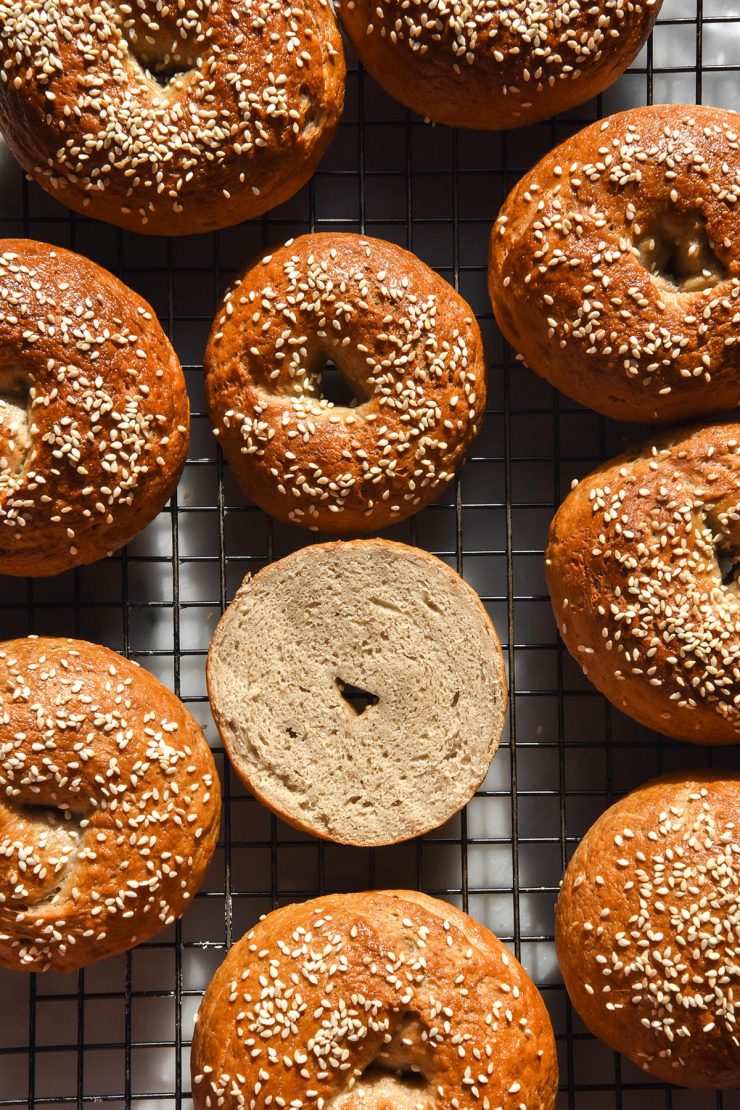
I recently published a recipe for gluten free high protein bread and realised it might also make for an excellent bagel. Obviously, it does, or you wouldn’t be scrolling past the intro to this recipe. Store bought high protein bagels that I was seeing on TikTok were actually the inspiration for the bread recipe, so I feel this concept has come full circle. Allow me to introduce: these gluten free high protein bagels.
Gluten free high protein bagels
These gluten free high protein bagels are xanthan gum free, nut free and easily egg free with an alternate egg wash. They use buckwheat flour and cottage cheese as the primary ingredients, both of which contain considerable amounts of protein (see the section below). The bagels uses psyllium husk powder as a binder and yeast for leavening.
The remaining ingredients – oil, maple syrup or honey and water – add flavour and a plush, soft crumb.
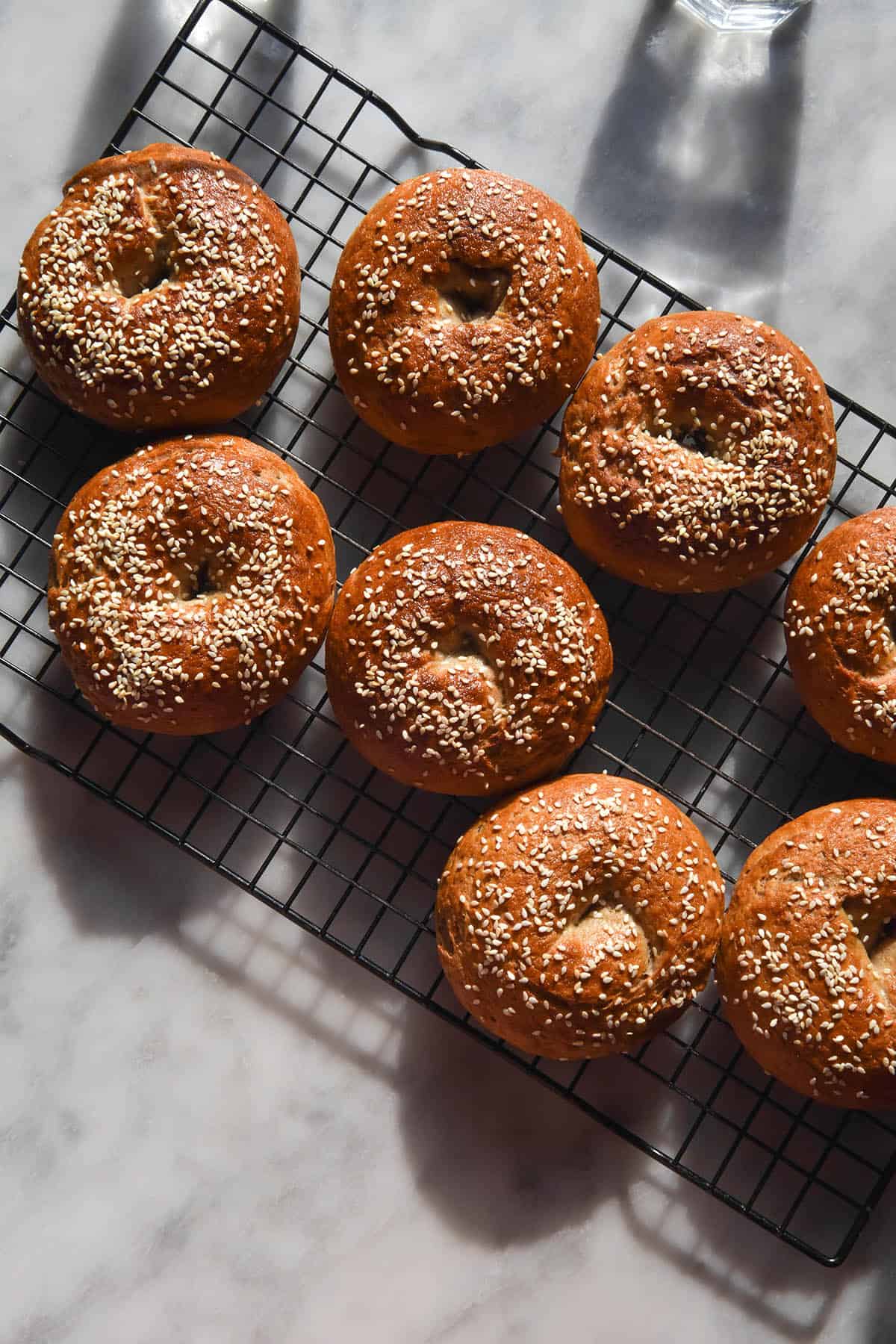
How much protein do these bagels contain?
Each bagel contains approximately 12g of protein. This depends a little on the brands you use, but the number should remain roughly the same. Both cottage cheese and buckwheat flour are high in protein, hence their inclusion in the recipe.
- 500g of cottage cheese with 12g protein per 100g = 60g
- 500g buckwheat flour (I used Coles brand which has 12.7g protein per 100g) = 63.5g
- 10 bagels divided by 123.5g protein = 12.35g protein per bagel
Are these bagels low FODMAP?
These bagels are easily made low FODMAP with a lactose free cottage cheese. This is available in some supermarkets in Australia, although I haven’t seen it everywhere. It is also excessively expensive, I find, when compared to regular cottage cheese. Lactose free dairy products are simply dairy products with lactase (an enzyme that breaks down lactose) added. It’s not a complicated process, so the extra cost is a bit of a joke in my opinion.
So, what to do? Make your own. Cottage cheese is easy to make at home, and you can use lactose free milk to do so. You can also take it a step further and make your own lactose free milk to make the process cheaper again.
All of the other ingredients are low FODMAP, including the buckwheat flour. Monash lists buckwheat flour as being low FODMAP in 100g serves per person. They do not currently specify an upper limit, which suggests that number could be even higher.

Are these gluten free high protein bagels xanthan gum free?
These bagels do not contain any added xanthan gum. However, most store bought cottage cheese brands tend to contain xanthan gum (and often guar gum as well).
In Australia, Barambah Organics make cottage cheese without xanthan gum or guar gum. Read the labels or Google to find a xanthan gum free brand where you live if you need it to be xanthan gum free.
Another option, as discussed above, is to make your own cottage cheese (I have a lactose free recipe here). It’s a relatively simple process that uses milk, lemon juice or vinegar, salt and perhaps some cream if you’d like it to be creamier.
Homemade cottage cheese doesn’t have the same defined lumps as store bought. I would say they are a result of the xanthan and guar gums. However, this recipe blends the cottage cheese anyway, so it’s the perfect place to use it.
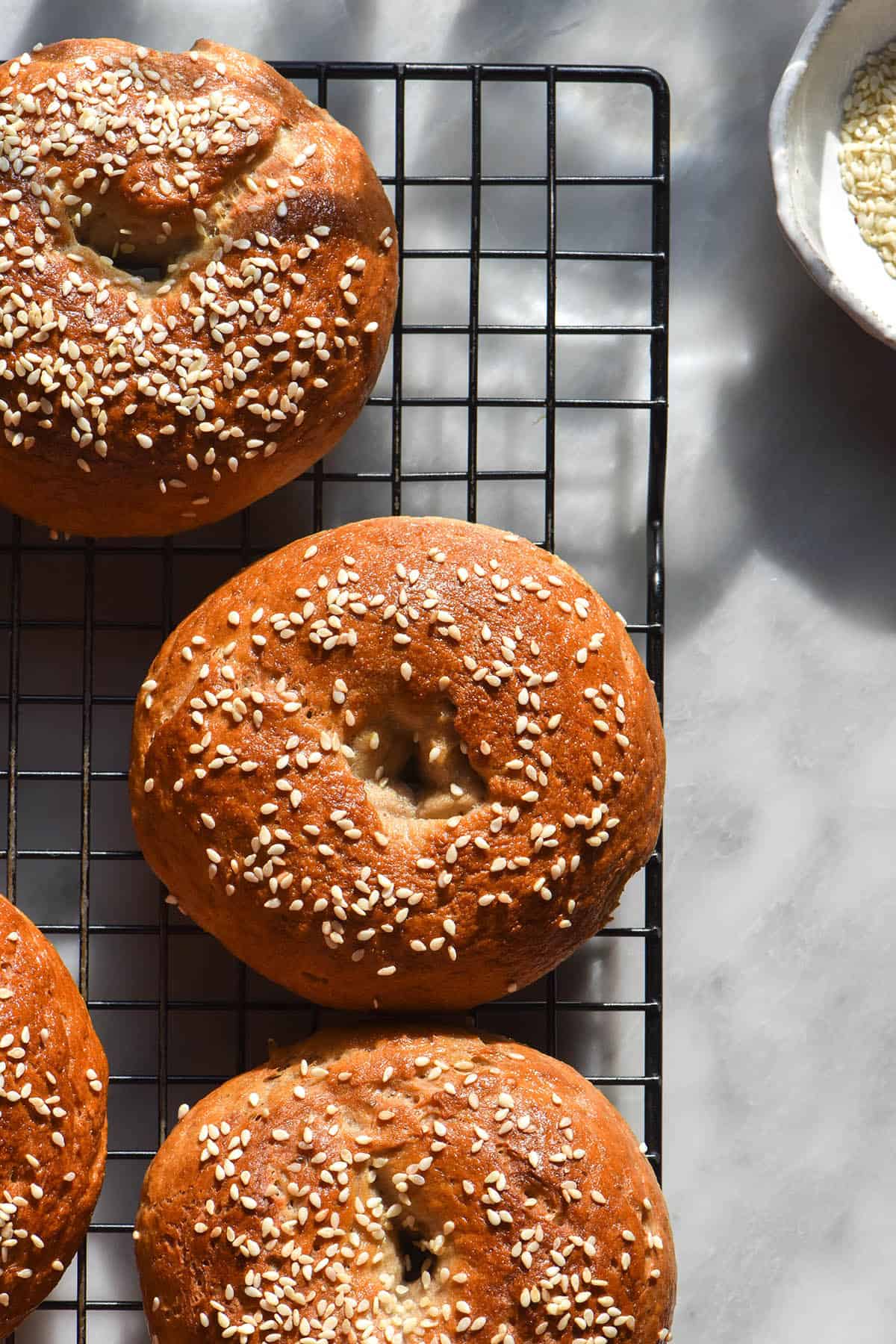
Recipe substitutions for your gluten free high protein bagels
There aren’t many!
- You can omit the sesame seeds and use poppy seeds or hemp seeds to top the bagels, or simply leave them plain.
- Maple syrup is a lower fructose/FODMAP alternative than honey. If you are making these bagels low FODMAP, use lactose free cottage cheese as well.
- I also have a low FODMAP, garlic and onion free everything bagel seasoning recipe here.
- Most neutral flavoured oils work in this recipe.
- I have not tested yeast free, sugar free or psyllium husk powder free versions of this recipe. Powder is the only variety of psyllium husk I use these days. I grind it myself in a spice grinder because I find store bought versions become quite grey once baked.
These bagels are designed around high protein ingredients, so substitutions aren’t really possible. However, I have a number of recipes that are suited to other diets.
- These 100% buckwheat flour bagels from my first buckwheat e-book are vegan/dairy free.
- My regular gluten free bagels are also vegan and don’t contain buckwheat flour, if it’s not your thing.
- My buckwheat bread recipe from my website is vegan/dairy free.
- If you just don’t like bagels, my gluten free high protein bread recipe is here.
- All of my favourite buckwheat flour recipes are here.
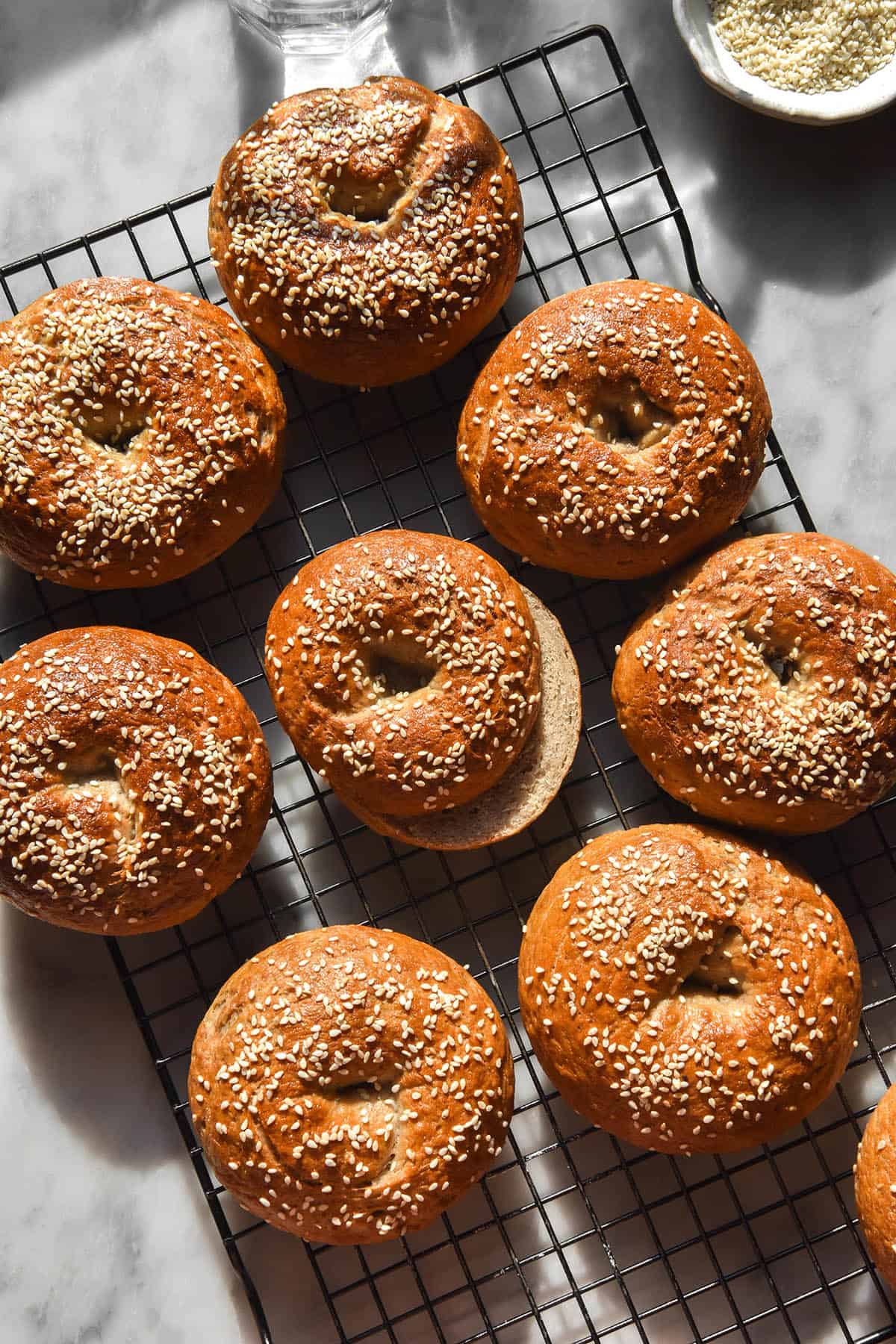
A note on hydration
You can play around with the hydration of this bagel dough as you see fit. The recipe card lists a more conservative amount of liquid. Consider that this is the same dough as the bread, but uses 200-300g less water.
To an extent, the more hydrated your dough, the softer and fluffier your bagels will be inside. They will still be chewy from the boiling, but the dough inside will be lighter.
Less hydrated dough equates to a denser, slightly drier inner bagel. It depends what you prefer, but also how comfortable you are working with high hydration dough.
The reason bagels use less hydration than the loaf is in part because the dough needs to be firm enough to handle and to shape into bagels. The dough can take more hydration, but it will become more difficult to shape the bagels.
It’s also worth noting that buckwheat flour can vary greatly in it’s absorption. You might need less water than me or you might need more. For this reason I generally find it easier to be slightly conservative with hydration and add more later if need be.
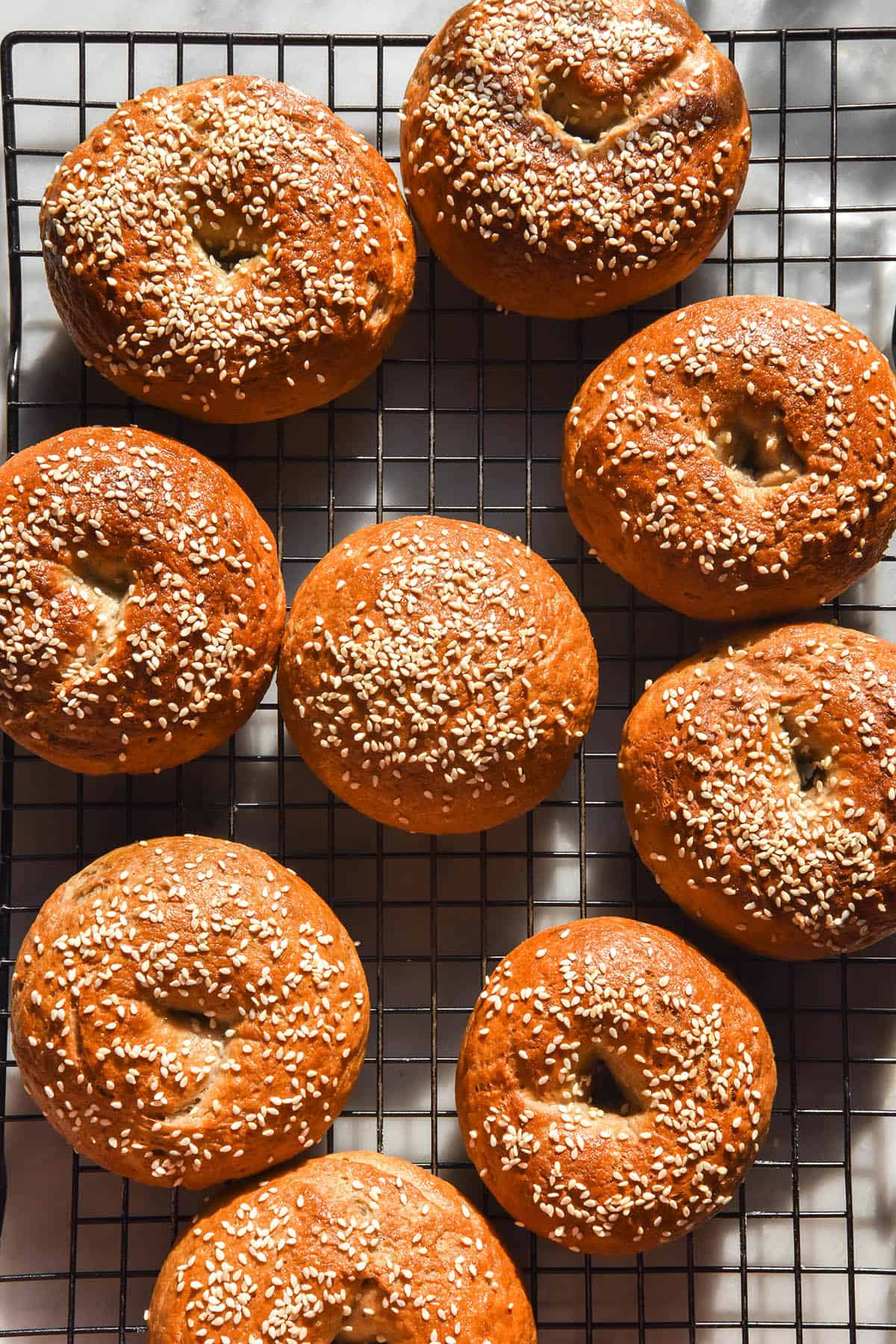
Gluten free high protein buns
A bonus recipe! This dough works equally well as a bun instead of a bagel. To make buns, simply divide the dough into 10 (same as the bagels) and shape it into tall, oblong shaped balls of dough. This will help them stand a little taller than if you shape them as squat balls of dough.
Proceed with the recipe as written, including the boiling. Boiling buns (as with my recipe here) helps them keep their shape and develop those classic shiny brown surfaces.
More gluten free bread recipes
- Grain free white bread
- Gluten free sourdough bread without rice flour
- 100% buckwheat flour sourdough bread from my buckwheat e-book
- My original gluten free sourdough bread recipe
- One chapter dedicated to gluten free yeasted bread and one dedicated to sourdough in my cookbook, Intolerance Friendly Kitchen
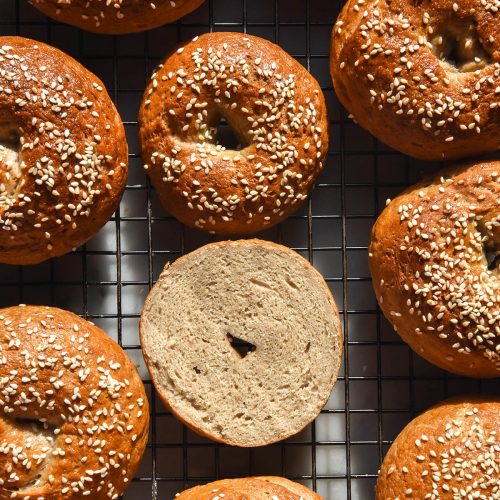
Gluten free high protein bagels
Ingredients
For the dough:
- 500 g light buckwheat flour
- 25 g psyllium husk powder
- 7.5 g (1 sachet)* yeast
- 5 g fine salt (see notes)
For the blended mixture:
- 500 g cottage cheese (see notes)
- 200 g water
- 60 ml (3 tablespoons)* neutral oil (I used vegetable)
- 40 ml (2 tablespoons)* maple syrup or honey
To finish:
- 1 teaspoon baking soda this helps create the shiny, brown bagel crust
- 1 egg whisked for egg wash or egg wash alternative
- Sesame seeds poppy seeds or bagel topping of choice
Instructions
- Whisk the dry ingredients for the dough in a large non-reactive (plastic or glass) mixing bowl.
- Combine the ingredients for the blended mixture in your blender and process until combined.
- Pour the blended mixture into the dry ingredients. Use a spoon and then your hands to mix until all the dry flour is picked up off the bowl. The dough should be thick and sticky but there should not be dry flour or crumbly bits of dough. Add 1 tablespoon water at a time if this is the case, and continue to work the dough until it becomes smooth.
- Cover the bowl and leave on the bench to proof for 30 minutes.
- While you wait, thoroughly preheat the oven to 180C/356F.
- Fill a medium pot 3/4 of the way with water. Set it over a medium heat and bring to a boil.
- Once the dough has proofed for 30 minutes, divide it into 9 or 10 balls. Depending on how sticky the dough is, you may need to lightly flour the bench (I use tapioca flour) or you may not.
- To form bagels, you can either roll out each piece of dough into a log and then brings the ends firmly together (use water on the ends to ensure they seal together) or you can form bagel sized disks of dough and use an oiled finger to create the bagel hole. Visually, I prefer the first option, but the second option is a bit easier and more foolproof.
- When the water has boiled, add the teaspoon of baking soda. It will bubble very briefly. Place each bagel into the water for 30-45 seconds, flipping halfway through. Place each boiled bagel on a lightly oiled cooling rack to drain the excess water while you boil the next one. Note that they will take on the indents of the rack, so place them with the prettiest side upwards.
- Once you have boiled all the bagels, place them on a lined baking tray.
- Brush each bagel with egg wash or an alternative, and then sprinkle with your chosen topping.
- Bake for 25-30 minutes or until golden, puffy and firm.
- If you are using a high hydration, wait until the crumb sets to eat one or else your bagel will be gummy. Leftovers keep really well for a number of days and can be frozen (I like to slice them prior to freezing).
Notes
- This recipe does not bloom the yeast, so make sure your yeast is well in date. If you are worried, bloom with 1/4 cup water and 1 teaspoon sugar. Subtract the water from the 200g for the dough.
- Cottage cheese already contains a decent amount of salt. Although the bagels (to me) don’t taste sufficiently salty without added salt, you can omit it for a low sodium diet. You can also make your own cottage cheese, then add salt to suit.
- My recipe for lactose free cottage cheese is here.
- Read the body of the post for notes and substitution options (or lack thereof). I have also linked other recipes that are suitable to vegan/dairy free diets.

No Comments